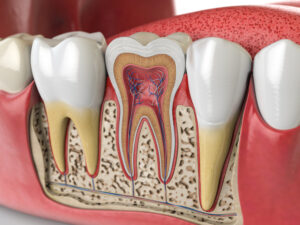How to Get Rid of a Tooth Infection
 Despite improvements in educating people about dental health, tooth infections remain a prevalent problem in the US. Tooth infections cause absences from school and work and can lead to significant pain. No one plans to have a tooth infection, so it is important for you to understand as much as possible so that you are prepared in the event that you or a loved one suffer from a dental infection.
Despite improvements in educating people about dental health, tooth infections remain a prevalent problem in the US. Tooth infections cause absences from school and work and can lead to significant pain. No one plans to have a tooth infection, so it is important for you to understand as much as possible so that you are prepared in the event that you or a loved one suffer from a dental infection.
What are the Different Types of Tooth Infection?
Tooth infections can originate in two different locations: around the tooth or inside the tooth. The infections that begin around a tooth are periodontal infections. Those that start inside the tooth are endodontic infections. The naming is rather simple, as the root perio- means “around”, and the root endo- means “within”.
Periodontal infections develop around the teeth due to untreated gum disease. The bacteria in dental plaque and tartar collect on the roots of the teeth under the gums without consistent oral hygiene and dental cleanings. This bacteria proliferates and destroys the tissues surrounding the teeth.
Endodontic infections occur when the nerve and blood vessels in a tooth (collectively called the pulp) have bacterial contamination. This can occur through deep, untreated cavities in a tooth or tooth cracks. Endodontic infections also arise from teeth that have “died” from past injuries.
Why are Tooth Infections Dangerous?
Both types of dental infections can rapidly spread into the surrounding jawbone. From there, they can move through various spaces to other areas of the body.
In rare instances, dental infections have spread from the jawbone into the spaces around the airway and caused death by asphyxiation. They can spread into the bloodstream and cause death through septicemia. Finally, certain dental infections can actually spread into the brain. These cases are rare, but tragic when they occur.
Will Prescription Antibiotics Cure a Tooth Infection?
 No!
No!
Many people think that dental infections are like other infections in the body. You take a course of prescription antibiotic medication, and it kills the infection. Right? WRONG!
Dental infections are unique in that oral, or even IV, antibiotics will never kill the source of the infection. For a periodontal infection, unless a dentist or dental hygienist physically removes the plaque and tartar buildup from the teeth, the source of the infection remains. For endodontic infections, unless your dentist removes the pulp tissue or the entire tooth, the source of the infection remains.
Taking a round of antibiotics will help you fight the infection, but the purpose of antibiotics in dental infections is only to reduce the infection so that you can comfortably proceed with dental treatment. If you take the antibiotics without undergoing any dental treatment, the infection will simply resume after the antibiotic effect wears off.
What are the Dental Treatment Options to Cure a Tooth Infection?
Now that we have firmly established the fact that dental treatment is the only way to cure dental infections, we can explain what those treatments are. The goal of treatment is to remove the source of the infection and provide a sustainable long-term result.
Periodontal Infections
The treatment options for a periodontal infection depend on the severity of the gum disease that is present.
Because the infection destroys the supporting structures around the teeth, a very severe infection may provide the patient with limited options for treatment. If the prognosis of saving a tooth or teeth is poor, your dentist will recommend extraction of the tooth or teeth. This is common when a periodontal infection has destroyed so much of the supporting structures that the teeth are loose.
When you and your dentist agree on saving the teeth with periodontal infection, the treatment will involve a comprehensive cleaning of the teeth and may involve surgery. The “deep cleaning” removes all of the bacteria buildup from the roots of the teeth, thus removing the source of the infection. With the source of the infection out of the way, it gives the body the opportunity to heal those surrounding structures and re-stabilize the teeth.
Surgery may be necessary to recontour the surrounding jawbone and gums after the cleaning. It could also include grafting to add new, healthy tissues to areas of deficiency of both bone and gum tissue.
Endodontic Infections
 When the source of the infection is within the tooth, you have two basic treatment options. 1) Remove the infected tissue from the hollow chamber in the tooth, or 2) Remove the tooth. Once the tissue inside the tooth contains bacteria and infection, it cannot heal itself. Antibiotics cannot reach it. Either you remove it, or you remove the entire tooth.
When the source of the infection is within the tooth, you have two basic treatment options. 1) Remove the infected tissue from the hollow chamber in the tooth, or 2) Remove the tooth. Once the tissue inside the tooth contains bacteria and infection, it cannot heal itself. Antibiotics cannot reach it. Either you remove it, or you remove the entire tooth.
Removing the tissue from the hollow chamber in the tooth is accomplished through a root canal treatment. Root canal treatments do not remove the root of a tooth; they remove the pulp tissue inside the tooth. After your dentist cleans the internal chamber of the tooth, she fills it with a biocompatible material, so to put it simply, a root canal treatment is a root filling.
A root canal treatment is the only treatment option for an endodontic infection that allows you to keep your natural tooth. The alternative is to remove the entire tooth with an extraction. Both of these treatments remove the source of the infection and allow your body to heal.
What Can I Do at Home while I’m Waiting for Dental Treatment?
There are a few home remedies that can help you manage pain and infection while you await a dental visit. You can fight inflammation in the gums with warm salt water rinses for 1-2 minutes up to five times daily. You can use other natural remedies with anti-inflammatory properties, like turmeric and tart cherry.
Natural remedies with antibacterial properties include garlic and clove oil. Garlic is available as an over-the-counter supplement in the vitamin aisle at your pharmacy. You can make a homemade mouthrinse with clove oil to fight pain and infection in the mouth. Make sure to use Grade A essential oils, which are therapeutic. Also make sure to avoid fragrance oils.
More Questions about Tooth Infections?
Call Designer Smiles today to schedule a consultation with Dr. Ann. She can answer any questions you have about tooth infections and assess your specific situation to help you choose the best course of action.
